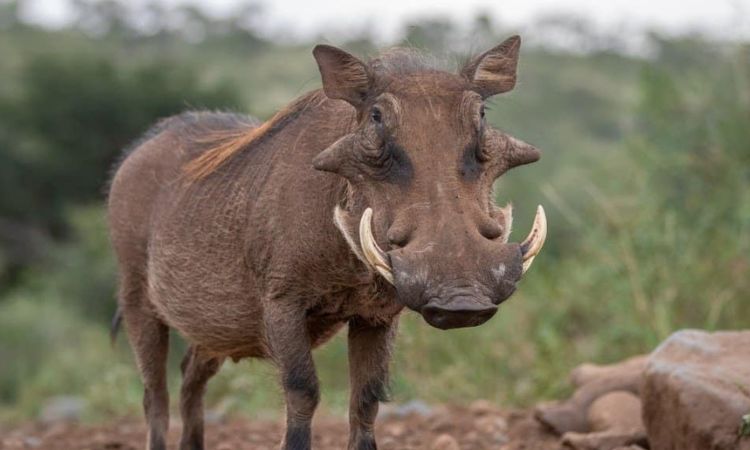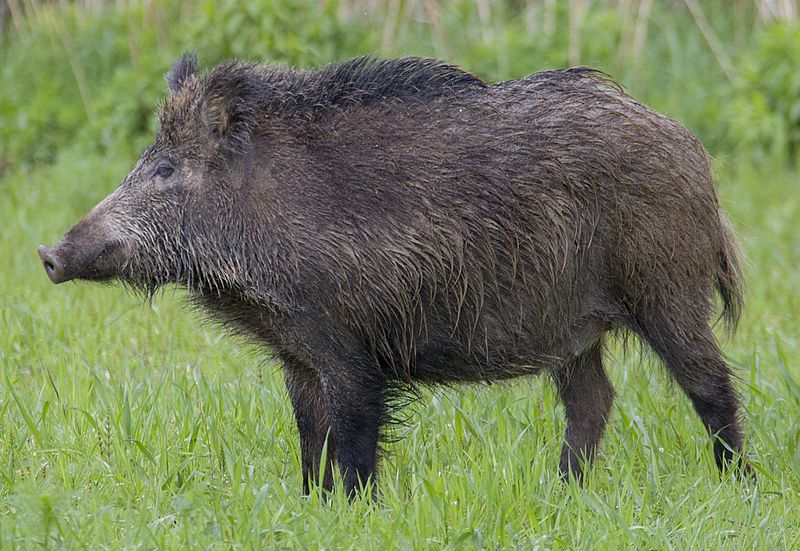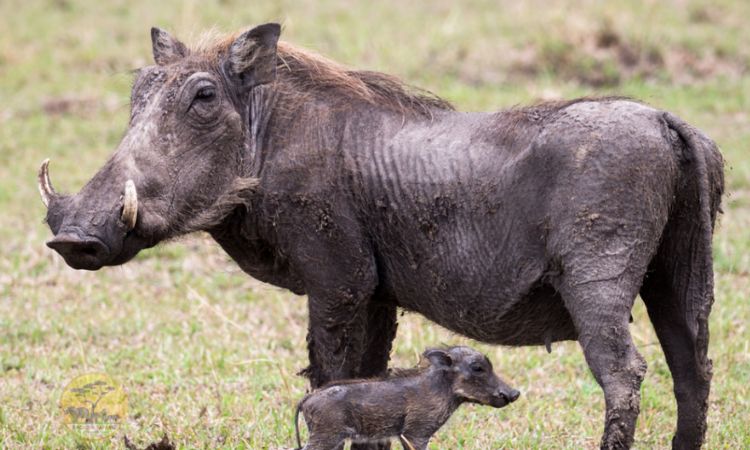8 Warthog Top Facts: warthog vs boar, Baby, Speed, Family, & more
Warthogs are among Africa’s most fascinating and distinctive animals, often recognized for their quirky appearance and behaviors. These resilient wild pigs, with their iconic tusks and wart-like facial growths, thrive in the diverse landscapes of sub-Saharan Africa.
Whether you’re a wildlife enthusiast or planning a safari adventure, this guide to warthog facts will uncover their habitat, diet, behavior, and unique adaptations. Let’s dive into the world of the African warthog and discover what makes these creatures so captivating.
What is a Warthog?
Warthogs (Phacochoerus africanus and Phacochoerus aethiopicus) belong to the Suidae family, which includes pigs, boars, and hogs.
The common warthog (P. africanus) is the most widespread species, found across sub-Saharan Africa, while the desert warthog (P. aethiopicus) is rarer, primarily inhabiting parts of East Africa.
These mammals are named for the wart-like protrusions on their faces, which are not actual warts but protective fatty growths.
Warthogs are herbivorous-omnivorous mammals known for their adaptability to various environments and their role in the African savannah ecosystem.
Warthogs are similar to pigs as both belong to the Suidae family, sharing traits like snouts and bristly hair. However, warthogs have unique facial warts, curved tusks, and kneel to graze, unlike most pigs. Native to Africa, they differ from domestic pigs in appearance and behavior.
Warthog Species
There are two types of warthog species and these include;
Common Warthog (Phacochoerus africanus)
The common warthog is widespread across sub-Saharan Africa, including Kenya, Tanzania, and South Africa. Known for its facial warts, curved tusks, and kneeling grazing, it thrives in savannahs and grasslands.
Social in sounders, it runs at 30 mph to escape predators. Its adaptability ensures stable populations despite habitat challenges.

Desert Warthog (Phacochoerus aethiopicus)
The desert warthog, found in Somalia, Ethiopia, and parts of Kenya, prefers arid regions. Smaller than its common cousin, it has less prominent warts and shorter tusks. It digs for roots in dry grasslands, living in small groups. Less studied, its population faces threats from habitat loss.
What is Warthog Known For?
Warthogs are renowned for their unique traits and behaviors, earning them a special place in Africa’s wildlife tapestry:
- Facial “Warts”: The wart-like protrusions on their faces (more prominent in males) are protective fatty growths, not actual warts, used during fights or to shield against predators.
- Kneeling to Graze: Warthogs are famous for kneeling on padded front knees to eat grasses or dig for roots, a behavior unique among pigs.
- Tail-Up Running: When fleeing danger, warthogs raise their tails like flags, helping group members stay together in tall grass.
- Burrow Dwellers: They use abandoned aardvark burrows for shelter, entering backward to face threats with their tusks.
- Tusks: Their two pairs of tusks (upper ones curving upward, lower ones sharp) are used for digging, defense, and establishing dominance.
These traits make warthogs a fascinating subject for wildlife lovers in Kenya, Tanzania, and beyond.
Warthog Speed
How fast can a warthog run? Despite their stocky build, common warthogs are surprisingly swift, capable of reaching speeds up to 30 miles per hour (48 km/h).
This agility helps them escape predators like lions, leopards, and hyenas, which are common in their habitats across South Africa, Zimbabwe, and Uganda.
Their speed, combined with quick directional changes, makes them difficult targets in the open savannahs of Kenya and Tanzania.
Warthog Size
Warthogs vary in size depending on sex and region:
- Length: Adults measure 3 to 5 feet (0.9–1.5 meters) from snout to tail.
- Height: They stand 25 to 33 inches (0.6–0.85 meters) at the shoulder.
- Weight: Males typically weigh 130–260 pounds (60–120 kg), while females are lighter, ranging from 100–165 pounds (45–75 kg).
Their large heads, sparse bristly hair, and prominent tusks give them a distinctive silhouette in the grasslands of South Africa and Zimbabwe.
Males are generally larger, with more pronounced facial warts, which are especially noticeable in populations in Kenya and Tanzania.
Warthog Baby
Baby warthogs, called piglets, are born after a gestation period of about 5–6 months. A typical litter consists of 2–4 piglets, though larger litters of up to 8 are possible.
At birth, piglets weigh around 1–2 pounds (0.5–1 kg) and are covered in fine hair. They rely heavily on their mother for protection and milk, staying close to her in burrows or sounders (family groups).
In Uganda and Tanzania, piglets are often seen trailing behind their mothers, learning to forage within weeks. Their playful antics, like chasing each other or exploring burrows, make them a favorite sight on safaris in Kenya and South Africa. Piglets are vulnerable to predators like jackals and eagles, so mothers are fiercely protective.

Warthog Lifespan
How long do warthogs live? In the wild, common warthogs typically live 11–15 years, though they can reach 18 years in captivity with proper care.
Their lifespan depends on factors like predation, food availability, and habitat conditions in regions like Zimbabwe, South Africa, and Uganda.
Warthogs’ adaptability, such as their ability to survive without water for months by consuming moist roots, helps them thrive in the challenging environments of Kenya and Tanzania.
Warthog Family
Warthogs live in social groups called sounders, typically consisting of females and their young. Males are more solitary, often leaving the sounder after reaching maturity (around 2 years) but may join during mating season.
Sounders usually include 1–3 adult females and their offspring, fostering strong family bonds. In South Africa and Zimbabwe, you’ll often see sounders foraging together or resting in burrows.
Males, known as boars, use their tusks to compete for mates, while females (sows) are nurturing and protective. In Kenya and Tanzania, sounders are commonly spotted near waterholes or grazing in savannahs.
Warthogs’ family dynamics, combined with their burrow-sharing habits, make them a cooperative species well-suited to Africa’s ecosystems.
Warthog Habitat
Warthogs are highly adaptable and thrive in a variety of habitats across sub-Saharan Africa. They prefer savannahs, grasslands, and woodlands, where they can find ample food and cover.
Warthogs are commonly found in countries like Kenya, Tanzania, South Africa, and Zimbabwe, often near water sources such as rivers or marshes, as they enjoy wallowing in mud to cool off and protect their skin from parasites.
Warthogs are known for using abandoned burrows, often dug by aardvarks, for shelter. These burrows provide protection from predators and extreme weather.
While they don’t create their own burrows, warthogs are skilled at modifying them with their tusks and snouts, making them ideal homes for resting or raising young.
Warthog Habitat in Key African Countries
Common warthogs are widespread across sub-Saharan Africa, thriving in savannahs, grasslands, and woodlands. Here’s how they adapt to specific countries:
- Kenya: Warthogs are abundant in national parks like Tsavo and Maasai Mara, where they graze in open plains and use burrows for shade.
- Tanzania: In Serengeti National Park, warthogs are a common sight, wallowing in mud near rivers to stay cool.
- South Africa: Kruger National Park hosts large warthog populations, where they dig for roots in grassy areas.
- Zimbabwe: Hwange National Park is home to warthogs that share burrows with other species like hyenas.
- Uganda: In Queen Elizabeth National Park, warthogs are seen near water sources, often running with tails up to evade predators.
Their ability to adapt to these diverse environments makes them a resilient species across African.
Warthog Diet
What do warthogs eat? Warthogs are primarily herbivorous but have an opportunistic diet. Their menu includes:
- Grasses: The bulk of their diet consists of short grasses, which they graze while kneeling.
- Roots and Tubers: Warthogs use their strong snouts and tusks to dig for nutrient-rich roots and bulbs, especially during dry seasons.
- Fruits and Berries: When available, they’ll snack on fruits, berries, and bark.
- Insects and Small Animals: Occasionally, warthogs eat insects, small reptiles, or carrion, making them omnivorous in lean times.
Their ability to kneel while foraging allows them to efficiently graze close to the ground, and their digging behavior helps unearth hidden food sources. This adaptability ensures they can survive in challenging environments where food may be scarce.
Warthog Behavior
Warthogs exhibit fascinating behaviors that make them stand out in the animal kingdom:
- Burrow Usage: Warthogs enter burrows backward, allowing them to face potential threats head-on with their tusks. Burrows serve as sleeping quarters, nurseries, and safe havens.
- Tail-Up Running: When fleeing danger, warthogs run with their tails raised like flags, a behavior that helps group members stay together in tall grass.
- Social Groups: Warthogs live in groups called “sounders,” typically consisting of females and their young. Males are more solitary but may join sounders during mating season.
- Wallowing: Warthogs love to roll in mud to regulate body temperature and deter parasites, often seen lounging in muddy pools.
Their social and survival behaviors showcase their resourcefulness and ability to thrive in the wild.

Predators and Threats
Warthogs face numerous natural predators, including lions, leopards, hyenas, and cheetahs. Their young are especially vulnerable to attacks from jackals and eagles. Warthogs rely on their speed, tusks, and burrows to evade predators, but they’re not defenseless—adult warthogs can deliver powerful charges or use their tusks to fend off attackers.
Human-related threats are also significant. Habitat loss due to agriculture, poaching, and human-warthog conflict (when warthogs raid crops) pose risks to their populations. While warthogs are resilient, these pressures can impact local populations in certain regions.
Adaptations
Warthogs have evolved remarkable adaptations to survive their harsh environments:
- Kneeling Pads: Their padded knees allow them to graze efficiently on low-lying vegetation, a unique trait among pigs.
- Tusks: Used for digging, defense, and establishing dominance during mating season, tusks are multi-purpose tools.
- Wart-like Growths: These fatty protrusions protect their faces during fights or predator encounters.
- Speed and Agility: Their surprising speed helps them escape danger in open savannahs.
- Burrow Use: By repurposing aardvark burrows, warthogs gain protection without expending energy on digging.
These adaptations make warthogs well-suited to their unpredictable habitats.
Warthog vs Wild Boar
How do warthogs compare to their cousin, the wild boar (Sus scrofa)? While both belong to the Suidae family, they differ in key ways:
|
Feature |
Warthog |
Wild Boar |
|
Habitat |
African savannahs, grasslands |
Forests, wetlands, global range |
|
Appearance |
Large head, facial warts, sparse hair |
Bristly hair, smaller head, no warts |
|
Tusks |
Two pairs, curved upward |
Single pair, straighter |
|
Diet |
Mostly herbivorous, some insects |
Omnivorous (plants, animals, crops) |
|
Behavior |
Kneels to graze, uses burrows |
Digs own wallows, more aggressive |
Despite these differences, both species are highly adaptable and share traits like intelligence and resilience.

Conservation Status
According to the IUCN Red List, the common warthog is classified as “Least Concern” due to its wide distribution and stable population. However, local populations may face declines due to habitat loss, human encroachment, and hunting.
The desert warthog, less studied, may be more vulnerable due to its limited range. Conservation efforts focus on protecting habitats and mitigating human-wildlife conflicts, such as preventing crop raiding.
Fun Facts About Warthogs
- Warthogs can live up to 15 years in the wild and up to 18 in captivity.
- Their name comes from the wart-like growths on their faces, which are more prominent in males.
- Warthogs are diurnal, meaning they’re active during the day, unlike many other pig species.
- They can go several months without drinking water, getting moisture from roots and plants.
- Warthogs are surprisingly good swimmers and often wallow in water or mud to stay cool.
FAQ: Common Warthog Questions
Are warthogs dangerous?
Warthogs are generally not aggressive toward humans unless threatened or cornered. Their tusks can cause serious injury, so it’s best to observe them from a safe distance.
How fast can a warthog run?
Warthogs can reach speeds of up to 30 miles per hour, making them surprisingly fast for their size.
Do warthogs really use their knees to eat?
Yes! Warthogs have padded knees that allow them to kneel comfortably while grazing on short grasses or digging for roots.
Where do warthogs live? Warthogs inhabit savannahs, grasslands, and woodlands across sub-Saharan Africa, often near water sources.
What animals prey on warthogs? Lions, leopards, hyenas, and cheetahs are their primary predators.
How do warthogs protect themselves? They use their speed, tusks, and burrows to evade or fend off threats.
